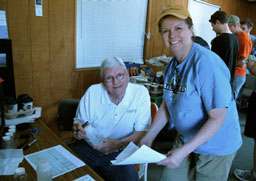photo by Flickr user jeff yielding
This article is a mashup of two pieces first published on Stream Team volunteer George Sims’ blog, The Bugs of Popo Agie. His group has worked hard to protect Bryant Creek, including a mile-by-mile water quality assessment report. Big thanks to George for sharing his story!
—
April 2, 2013 – “Down the Creek Without a Paddle”
John and Sue and I put our kayaks and canoe in at the “Monastery Bridge” in Douglas County, only a mile or so from Assumption Abbey, a Trappist monastery, and paddled over ten miles downstream to the Highway 95 bridge, just below the Ozark County line.
In addition to enjoying a great day of sun, fun, and good companionship, we were conducting chemical monitoring of the stream at one-mile intervals as part of the State of Missouri’s Volunteer Water Quality Monitoring (VWQM) program. This endeavour provides free training to individuals, enabling them, in the Introductory training, to learn to identify “aquatic macroinvertebrates” (bug larva) as indicators of water quality.
John is a Level 3 monitor, so he provided the “adult supervision” for Sue and me. Our Master Naturalist chapter, based in West Plains, developed an ambitious project in 2010, whereby we would monitor every mile of the 42+ mile, floatable portion of Bryant Creek, from the Vera Cruz MDC (Missouri Conservation Department) access, down to the confluence of Bryant with the North Fork of the White River at Tecumseh.

We divided the stream into four sections, with a team leader responsible for each segment. As my segment was substantially longer than the others, John and Sue graciously lent their help in covering almost 2/3 of the nearly 18-mile stretch.
Early on, we passed a crystalline spring, which issued from a cave on the left hillside, tumbling over mossy rocks down to the creek.
The temperatures rose to nearly 80 during the day, and I only managed to sink my kayak TWICE, an improvement of 33% over last year’s outing, although I DID manage to lose my paddle in the process. Fortunately, John had brought an extra, so I was not left to live in the wilderness, eating lichens, and slowly starving and turning feral.
We sampled twelve sites, and managed to reach the take-out point just as darkness descended. All the data was organized, and submitted electronically to the Missouri Stream Team program, a truly wonderful undertaking, which involves over 4,000 volunteer “stream teams” which clean, monitor, and enjoy Missouri’s beautiful waterways.
A truly great way to spend a day, with good friends, a beautiful stream, and a worthwhile reason to be there.
Can you imagine a piece of the universe more fit for princes and kings?
I’ll trade you ten of your cities for my Bryant Creek, and the pleasures it brings.
Out on the Bryant, on soft summer nights,
Bonfires blaze, to the children’s delight.
They dance ’round the flames, singing songs with their friends,
I wish I was with them again.
Bryant Creek is part of the North Fork of the White River Watershed, and is a lovely place to fish, swim, or float. All water quality data is submitted to the State of Missouri’s Stream Team program, and is also compiled into an ongoing report, complete with data, graphs, bells and whistles.The complete text of the report, through 2012, is given in pdf form at the link below.
BCAP Ongoing Report





















